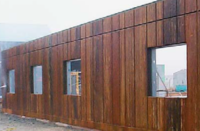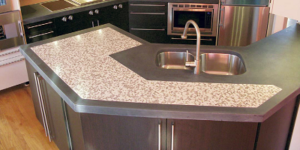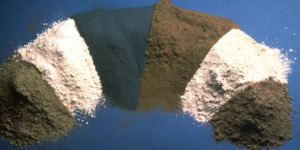
White cement concrete. The name pretty much says it all. According to the Portland Cement Association, white portland cement has essentially the same properties as gray cement, except for when it comes to color.

The color comes from the raw materials and the manufacturing process, explains Tina McIntyre, Western states marketing manager for Texas Industries Inc. Metal oxides influence the whiteness and undertone of cement, she says. “And there are less iron and manganese in white compared to gray.”
White cement was first produced in the United States back in 1907, the PCA reports, in York, Pa. Still the specialty product remains an anomaly, representing only 1 percent of the cement used throughout the country. The lion’s share still belongs to gray.

But observers in the industry say that white cement is strengthening its position in the marketplace as more and more contractors discover its potential. They credit this to the rise in popularity of decorative concrete and the green building movement. “Concrete is one of the most green products out there,” McIntyre notes.
And as the public embraces the whole green concept and clamors for sustainable products, they are discovering the many uses of colored concrete, from countertops and furniture to fireplace surrounds and floors. And that puts an even bigger spotlight on white cement.
Whiter whites, brighter colors
White cement, proponents say, offers many advantages over its gray counterpart. The No. 1 reason contractors choose the product is that its results are more aesthetically pleasing. “You’ll never get ‘Target’ red if you add a red pigment to gray cement,” McIntyre says. “At best, it’ll be a murky red.”

Buddy Rhodes of Buddy Rhodes Concrete Products has been using white cement since the early 1980s. Today, he uses nothing but the white stuff. “You’re able to color and control color so much better with white,” says Rhodes, whose company packages its own bone-white Concrete Counter Mix. “With gray, you always get a different shade and are constantly fighting the grayness.”
And if its gray you’re looking for, he adds, “you can get a really beautiful gray with white.” The same holds true for a piece that is intended to be black.
Rhodes uses white because he’s assured of consistent color, he explains. “It keeps the variables out of the mix design. I just change techniques for different finishes.”
Besides more vibrant and purer colors, Rhodes continues, the white medium shows off aggregates such as recycled glass, oyster shells and marble chips much better. “The colors really pop,” he says.

Matt Hine, president of Progressive Concrete Coatings in Wilmington, N.C., agrees. The contractor specializes in acid-staining countertops and floors. “The advantage for me is to have a brighter base color,” he says. “The colors are more vibrant and bold on a white base, and there’s a sharper contrast among the variations of colors and tones. These slight variations are enhanced to create a more striking mottled appearance.”
If on the other hand, the customer is looking for a muted, subtle or solid color, Hine uses gray cement. “Not everybody likes the variation in color and contrast,” he says.

Sometimes, Hine uses a combination of the two. Brandon Gore of Gore Design Co. in Tempe, Ariz., does too. While he uses pure white cement to make many of his renowned erosion sinks, he regularly employs a 50-50 blend of white and gray to create a color he calls limestone. Gore says he isn’t a big fan of brightly colored concrete and discourages his customers who request it. Instead he focuses on white, charcoal, natural gray and his limestone mix.
He also shies away from using pigments of any kind, preferring to color his products with portland white or gray cement. “I like to keep everything natural,” Gore says.
The dark side of white
Unlike other contractors interviewed, Ben Ashby, owner of Concrete Encounters in Utah and a partner with Concrete Solutions, is not a fan of white concrete. “I hate it,” he says, “and I don’t understand the big fascination with it. It’s more susceptible to cracking.”
An acceptable concrete mix should have a minimum of five gradations of sand, Ashby explains. “The more gradations of sand, the tighter the mixture. (If it has less,) the matrix isn’t tight enough and it leaves holes like Swiss cheese. Those holes have to be filled with something and that something is cement.”

Proper-sized white aggregates can be hard to find, so they are sometimes left out of some mixes. When that happens, cement fills the voids where the aggregate should be.
And cement is the weakest part of the mix, Ashby says. It’s in these areas that cracks are likely.
Cement also has a tendency to go off-white, Ashby continues, so pure white aggregates are needed to create a brilliant white concrete. “These aggregates are hard to find and are expensive. I mean, when was the last time you saw a white mountain?”
To get the proper-sized white aggregates requires a special order, which could mean high shipping costs and fewer profits.
Besides that, Ashby contends, white cement lends itself more to contemporary colors. “And I’m not contemporary,” he says. “I like earth tones.” He can create earth tones just fine with regular gray cement, he says.

“If you’re not familiar with white cement, it may act a little differently than the cement you’re used to,” says Bernie Igusky, director of logistics, marketing and technical services for Federal White Cement, an Ontario-based company that distributes its product throughout the United States. Others won’t notice a difference. This perception, he adds, varies depending on what part of the country you’re in.
“But for all practical purposes, it acts similar to gray concrete,” maintains Igusky, who also chairs the PCA White Cement Subcommittee. “White cement may be ground finer and may set faster, but there’s no general rule.”
Gore says in Phoenix, where it gets really hot, white cement sets up quicker and it’s a little trickier to work with. “You have to move faster with it,” he says, “but it’s a little easier to finish.” To help slow the set, he says he and his staff use ice water.
But the biggest challenge surrounding white concrete is its cost. “We pay $30 to $35 for a bag of white as opposed to $7 or $8 for gray,” says Gore. ”It depends on where you are, where they quarry and the shipping costs.”
Rhodes says white cement usually retails for about three times that of gray, maybe more depending on where you are. Hine says he pays three to four times more for white than gray in North Carolina.
“That’s one of the hurdles that has to be cleared,” says McIntyre. “In the long run, it’s more expensive and contractors know that, but the end result is worth the price. You’re paying more for a premium product.”

White cement also needs its own storage bin separate from the gray, notes PCA program manager of masonry and special products Jamie Farny. And ready-mix trucks that carry white cement concrete must be thoroughly cleaned to prevent color contamination.
When working with white cement, you have to use the right finishing tools so you don’t discolor it. “It will show the marks of a magnesium trowel,” Rhodes says. Use a stainless-steel trowel or, better yet, a Plexiglas trowel. Also, your mixing drum should be made of a poly material rather than metal. “Metal will wear and turn the mix gray, defeating the purpose,” Rhodes says.
Hidden talents
Whereas most proponents of white cement will agree that its aesthetic qualities have fueled the product’s rise in popularity, it has other redeeming qualities when it comes to safety and how white-cement concrete behaves when exposed to sunlight, Farny says.
White cement used for pedestrian walkways and parapet walls on bridges, for example, offer improved safety because of their high visibility. Lighting requirements in projects such as parking lots are reduced because of the product’s reflectivity. Finally, white cement used on buildings in big cities can help to reduce urban heat islands, because the buildings don’t absorb as much heat as their darker counterparts. They’re cooler both inside and out.
Facts about white cement
In North America, white cement is largely produced by three manufacturers: TXI, Federal White Cement Ltd. and Lehigh Cement Co. – White Cement, according to the Portland Cement Association’s program manager of masonry and special products Jamie Farny. White cement is readily available throughout the United States and Canada.
Of the five basic types of portland cement conforming to ASTM C150, white cement is generally produced as I, II, III or V, with general-purpose Type I and high-strength Type III being the most common. Types II and V are, respectively, moderate and high-sulfate-resistant cements, which offer protection against sulfate attack from soil or groundwater.















